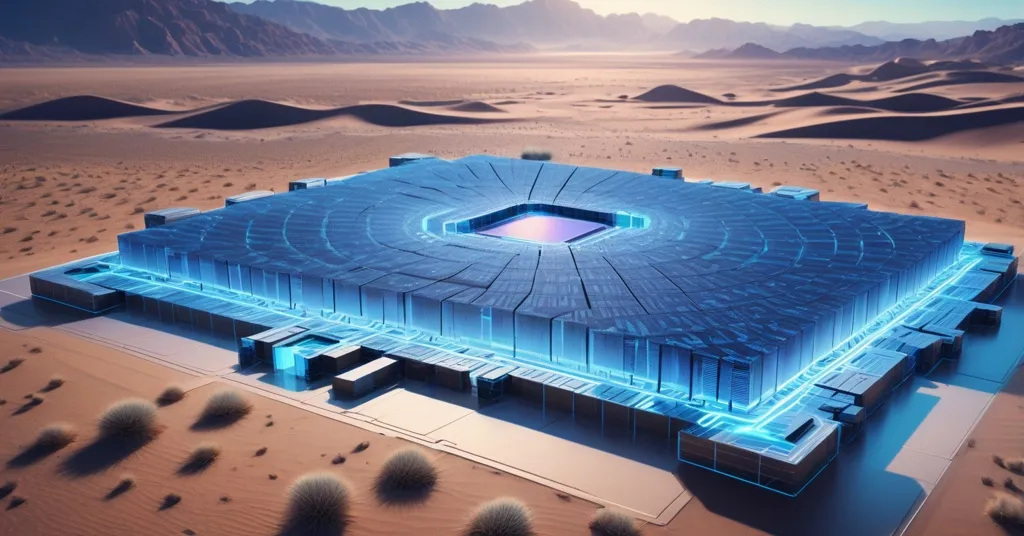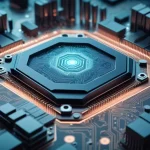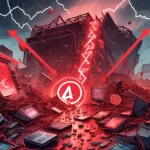Nvidia’s Blackwell Wafer Debuts in U.S.: Boosting AI and Crypto Tech Sovereignty

Nvidia Unveils First Blackwell Wafer at TSMC’s Phoenix Facility: A Bold Step for U.S. AI and Tech Sovereignty
Nvidia has made a groundbreaking announcement with the production of the first Blackwell wafer at TSMC’s Phoenix, Arizona facility, signaling a seismic shift in the U.S. role within the AI and tech landscape. This isn’t just a technical achievement; it’s a strategic maneuver to anchor American leadership in a fiercely competitive global race for AI dominance, with potential ripple effects even reaching into the crypto and blockchain spheres.
- Historic Production: First Blackwell wafer manufactured in the U.S. at TSMC’s Phoenix site, strengthening domestic AI supply chains.
- Colossal Investment: Nvidia commits $500 billion to AI infrastructure, betting big on U.S.-centric innovation.
- Powerhouse Alliances: Partnerships with OpenAI, Intel, and others aim to cement Nvidia’s grip on AI hardware and data center expansion.
Blackwell Wafer: Why It’s a Game-Changer
The debut of the Blackwell wafer at TSMC’s Phoenix facility isn’t just another press release—it’s a declaration of intent. Nvidia CEO Jensen Huang, speaking directly to TSMC employees, didn’t mince words about the gravity of this moment:
“You built something incredible, but you will realize in time that you are part of something historic. The single most important chip is now being produced in America.”
So, what exactly is this wafer, and why the hype? For those new to the tech game, a wafer is a thin disc of silicon that serves as the base for crafting integrated circuits—essentially, the building blocks of modern chips. The Blackwell wafer, named after Nvidia’s cutting-edge architecture, is engineered for extreme performance, particularly in artificial intelligence workloads. Compared to previous generations, Blackwell boasts significantly higher processing speeds and energy efficiency, making it ideal for training massive AI models that power everything from language bots to self-driving cars. Think of it as the turbocharged engine of the AI era, and now, it’s being built on U.S. soil with Nvidia’s announcement of the first Blackwell wafer production at TSMC’s Phoenix site.
This production milestone at TSMC—short for Taiwan Semiconductor Manufacturing Company, the world’s top chip fabricator—marks a critical pivot. The Phoenix facility is no small operation; it’s designed to produce advanced chips at 2, 3, and 4-nanometer scales, alongside A16 processors. For the uninitiated, “nanometer” refers to the size of transistors on a chip—smaller means more power and efficiency crammed into less space. These chips are vital not just for AI, but for telecommunications, gaming, and other high-performance computing needs that demand lightning-fast data crunching. By bringing this tech stateside, Nvidia and TSMC are laying the foundation for what Huang calls “AI factories”—massive data centers dedicated to processing the insane computational loads of next-gen tech.
Nvidia’s $500 Billion Bet on AI Infrastructure
Nvidia isn’t stopping at one wafer or one factory. The company has unveiled plans to invest a staggering $500 billion into AI infrastructure over the coming years, though exact timelines remain murky. This isn’t pocket change—it’s a war chest aimed at building out data centers, training facilities, and the backbone of a U.S.-led AI ecosystem. Huang himself underscored the sheer audacity of this vision:
“Developing these AI supercomputers is one of the most difficult systems challenges people have ever attempted.”
He’s dead right. The hurdles aren’t just technical; they’re existential. These AI factories guzzle energy like a fleet of 747s, raising hard questions about grid capacity and sustainability. Can the U.S. infrastructure keep up, or are we staring down rolling blackouts while Nvidia plays tech god? Then there’s the raw manpower needed—thousands of highly skilled workers to design, build, and maintain these systems. Add in supply chain logistics for rare materials, and you’ve got a puzzle that could stump even the brightest minds at Nvidia. Still, if successful, this investment could redefine the U.S. economy, creating high-paying jobs and positioning America as the epicenter of AI innovation.
Strategic Partnerships: Building an AI Fortress
Nvidia isn’t going it alone. They’ve assembled a roster of heavy hitters to secure their dominance in AI hardware and computing capacity. A $40 billion deal with BlackRock, xAI, and Microsoft to acquire Aligned Data Centers shows a ruthless push to expand data center footprints—think of these as the physical hubs where AI models are trained and hosted. Then there’s a potential $100 billion investment in OpenAI, the brains behind ChatGPT, where Nvidia would supply critical hardware while OpenAI collaborates with Broadcom and AMD for additional AI chip production. Not content to stop there, Nvidia is also snapping up $5 billion in Intel shares, securing a 4% stake in the legacy chipmaker. Meanwhile, CoreWeave, a cloud computing player, has locked in a $14 billion deal with Meta to provide raw processing power.
These aren’t just business moves; they’re a calculated play to control the future of compute. Each partner brings something unique—OpenAI’s software prowess, Intel’s manufacturing legacy, Microsoft’s cloud expertise—but the risk of market concentration looms large. If Nvidia and a handful of giants hoard all the processing power, where does that leave smaller innovators? Could we end up with an AI oligarchy, gatekeeping access to the tech that’s supposed to democratize intelligence? It’s a sobering thought amid the hype.
Geopolitical Stakes: U.S. Tech Sovereignty on the Line
Zoom out, and the Blackwell wafer’s production is more than a tech story—it’s a geopolitical chess move. For decades, the U.S. has relied heavily on foreign manufacturing, particularly from Taiwan, where TSMC’s headquarters churn out most of the world’s advanced chips. That dependence is a vulnerability, especially with rising tensions in the Asia-Pacific. Nvidia’s shift to Phoenix, backed by policies like the CHIPS and Science Act which funnels billions into domestic semiconductor production, is a direct response. It’s about reducing risks and asserting technological independence.
The TSMC Arizona facility is a cornerstone of this strategy. Beyond cranking out cutting-edge chips, it’s projected to create thousands of advanced manufacturing jobs and lure suppliers to set up shop nearby, fostering a self-sustaining tech hub. TSMC itself is cashing in on the AI boom, recently posting record profits and hiking revenue forecasts as demand for AI hardware skyrockets. But let’s not get too starry-eyed—projects of this scale often face delays, cost overruns, or political meddling. And while onshoring mitigates some risks, global supply chains for rare earths and other materials aren’t so easily domesticated. A single trade spat could still send shockwaves through even the best-planned initiatives.
Crypto Connections: Could Bitcoin and Blockchain Benefit?
For those of us in the Bitcoin and blockchain camp, Nvidia’s moves carry intriguing implications, even if AI isn’t our core focus. As a Bitcoin maximalist, I believe BTC is the ultimate sound money and censorship-resistant store of value—full stop. It doesn’t need to be everything to everyone. Yet, the infrastructure Nvidia is building could indirectly turbocharge the crypto space. Imagine Blackwell-powered chips slashing energy costs for Bitcoin mining rigs by optimizing hash rate efficiency. Or consider how enhanced GPUs could accelerate transaction processing on layer-2 solutions or even boost Ethereum’s smart contract execution post-merge, filling niches Bitcoin rightfully ignores.
There’s also the potential for synergy between AI and decentralization. Projects exploring decentralized AI—think training models on blockchain networks for transparency and data integrity—could leverage Nvidia’s hardware for scalability. We’ve seen early experiments like Fetch.ai or SingularityNET aiming to merge AI with distributed ledgers. If Nvidia’s tech lowers the computational barrier, we might see an explosion of such innovations. Of course, this is speculative—Nvidia’s focus is squarely on AI, not crypto-specific hardware. There’s a risk their priorities sideline blockchain needs, leaving miners and developers scavenging for scraps. Still, the spillover effects of raw compute power are hard to ignore for anyone rooting for a decentralized future.
Risks and Roadblocks: Playing Devil’s Advocate
Before we get carried away with visions of tech utopia, let’s slam on the brakes and face the ugly side. Nvidia’s $500 billion gamble could blow up in spectacular fashion. Energy demands for AI data centers are already a nightmare—some estimates suggest they could consume as much power as entire small countries within a decade. If the U.S. grid buckles, Nvidia’s grand plans might spark more blackouts than breakthroughs. Then there’s the environmental angle; crypto folks know the heat for Bitcoin mining’s carbon footprint, and AI factories could draw even fiercer scrutiny. Are we just trading one eco-villain for another?
Market concentration is another beast. Nvidia’s web of partnerships—while impressive—smells like a monopoly in the making. If a few tech titans control the AI compute pipeline, smaller players, including blockchain startups, might get crushed underfoot. And geopolitically, onshoring sounds great until you realize the world’s still interconnected. A hiccup in rare material imports or a retaliatory trade war could kneecap these initiatives faster than you can say “supply chain crisis.” Nvidia’s playing 4D chess, but even grandmasters slip up when the board gets flipped. Let’s hope they’ve got a backup plan—or ten.
Key Takeaways and Burning Questions
- How does the Blackwell wafer’s U.S. production impact global AI supply chains?
It’s a major shift, reducing American reliance on foreign chip manufacturing and positioning the U.S. as a potential leader in AI tech, though it challenges existing global dynamics and could spark pushback. - What might Nvidia’s $500 billion AI investment mean for the U.S. economy?
It promises a surge in jobs and tech innovation, but the colossal energy demands and environmental costs of AI data centers could offset gains if not addressed. - Are Nvidia’s partnerships creating a dangerous monopoly in AI hardware?
Quite possibly—with deals spanning OpenAI to Intel, Nvidia risks dominating compute power, potentially sidelining smaller innovators and raising antitrust red flags. - What are the biggest challenges facing these massive AI infrastructure projects?
Energy constraints, logistical nightmares, skilled labor shortages, and geopolitical supply chain risks all threaten to derail Nvidia’s ambitious roadmap. - How could AI advancements from Nvidia benefit Bitcoin and blockchain tech?
Enhanced chips could optimize Bitcoin mining efficiency or scale decentralized AI on blockchain networks, though Nvidia’s AI focus might neglect crypto-specific hardware needs. - Will energy constraints impact both AI and Bitcoin mining in similar ways?
Absolutely—both sectors face scrutiny for high power usage, and Nvidia’s data centers might intensify grid pressures, mirroring challenges already familiar to crypto miners.
Nvidia’s rollout of the Blackwell wafer at TSMC’s Phoenix facility is a middle finger to supply chain fragility and a ballsy bet on U.S. tech supremacy. It’s a moment of optimism for those of us who champion disruption and decentralization, with potential downstream boosts for Bitcoin and blockchain innovation. But the path forward is littered with landmines—energy crises, market overreach, and global tensions could turn this dream into a dumpster fire. For now, Nvidia’s building the future of compute. The real question is whether that future will be a centralized fortress or a decentralized playground for rebels like us in the Bitcoin space. Time’s the only judge.



